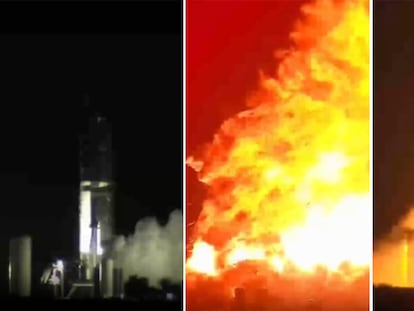Elon Musk's Starship mega-rocket completes first unexploded flight in 2025
SpaceX's Starship mega-rocket successfully completed its tenth test launch on Tuesday after three failed attempts. Starship lifted off at 6:30 p.m. local time (1:30 a.m. Spanish time) from SpaceX's base in South Texas (USA) after two postponements due to technical and weather issues, and the upper part of the craft safely landed in the Indian Ocean one hour and six minutes later.
The rocket is composed of the Super Heavy booster and the Starship spacecraft, and SpaceX's goal is to find the key so that both parts can be reused in future missions and reduce costs in its efforts to return to the Moon and reach Mars, major goals of the aerospace company's owner, magnate Elon Musk.
The three previous tests resulted in the loss of the Starship, requiring SpaceX to make multiple modifications. The investigation into the failure of Starship's ninth flight on May 27 determined that fuel leaks affected the ship's stability control, ultimately causing it to explode. It also removed a significant number of the ship's tiles to test the limits of its vulnerable areas during re-entry into Earth's atmosphere.
The test, which lasted just over an hour, was broadcast live online via cameras on the craft and on Starlink satellites, also owned by Musk, and was occasionally interrupted by cheers from employees as milestones were passed, such as the separation of the booster and craft. Super Heavy separated from Starship about seven minutes after takeoff and landed in a controlled manner in the waters of the Gulf of Mexico, south of the United States, as expected, but it is unclear if it was in one piece.
SpaceX also managed to perform two tests that it couldn't in its three previous failed test flights: simulating satellite deployment with dummy aircraft through a side hatch of the craft and restarting an engine during flight, something SpaceX executives noted as a significant first. Starship then continued its upward trajectory into space and about 45 minutes after takeoff began its re-entry into the atmosphere, reaching subsonic speed toward its final destination: the Indian Ocean.
Do you want to add another user to your subscription?
If you continue reading on this device, it will not be possible to read it on the other device.
ArrowIf you want to share your account, upgrade to Premium, so you can add another user. Each user will log in with their own email address, allowing you to personalize your experience with EL PAÍS.
Do you have a business subscription? Click here to purchase more accounts.
If you don't know who's using your account, we recommend changing your password here.
If you decide to continue sharing your account, this message will be displayed indefinitely on your device and the device of the other person using your account, affecting your reading experience. You can view the terms and conditions of the digital subscription here.

EL PAÍS





